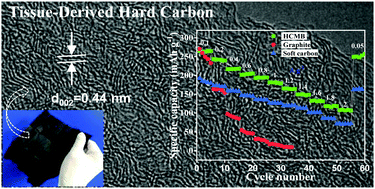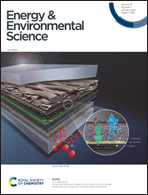Tissue-derived carbon microbelt paper: a high-initial-coulombic-efficiency and low-discharge-platform K+-storage anode for 4.5 V hybrid capacitors†
Abstract
Hard carbon (HC) is a promising anode material for K+-storage due to its randomly oriented turbostratic structure. However, most reported HC anodes exhibit low initial coulombic efficiency (ICE) and no obvious discharge platform during K+-intercalation/deintercalation, thus restricting their practical application. Herein, cheap and renewable sanitary tissue is utilized as the precursor to construct a flexible self-supporting hard carbon microbelt paper (HCMB). As a binder-free anode, the HCMB can achieve a high ICE value of 88% with a high charge capacity below 1 V (204 mA h g−1 at 100 mA g−1), excellent rate capability (151 mA h g−1 at 1000 mA g−1) and superior cycling stability in a conventional KPF6-based electrolyte. More importantly, the HCMB-based anodes exhibit a rather low discharge platform, which is close to a graphite anode (0.25 V vs. K/K+). To demonstrate its practical use, a novel 4.5 V potassium ion capacitor (PIC) device is successfully constructed based on the HCMB anode and an activated carbon cathode together with a gel polymer electrolyte. The energy density of this hybrid system is up to 152 W h kg−1, and is still maintained as high as 112 W h kg−1 at a high power density of 17 500 W kg−1. In addition, the effect of the carbonization temperature on the K+-storage behavior of HCMB and its comparison with carbon counterparts (graphite and soft carbon) are systematically investigated.

- This article is part of the themed collection: Energy & Environmental Science Recent HOT Articles


 Please wait while we load your content...
Please wait while we load your content...